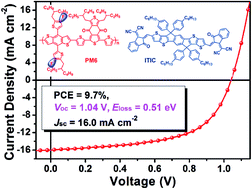26 May 03:28
by Wenchao Zhao, Sunsun Li, Huifeng Yao, Shaoqing Zhang, Yun Zhang, Bei Yang and Jianhui Hou

Journal of the American Chemical Society
DOI: 10.1021/jacs.7b02677

04 May 10:35
by So-Huei Kang, Tanya Kumari, Sang Myeon Lee, Mingyu Jeong, Changduk Yang
Dithienyldiketopyrrolopyrrole (DPP2T) and thieno[3,2-b]thiophene (TT) building blocks, enabling a large intermolecular overlap through π–π stacking, into an amorphous-like polymer composed of benzo(1,2-b:4,5-b′)dithiophene (BDT) and fluorinated thieno[3,4-b]thiophene (QTT), are introduced. Herein, through the variation of relative compositions of DPP2T-TT and BDT-QTT in the polymer backbone, the synthesis and characterization of a series of condensed random 2D-2A “quarterpolymers” with two reference alternating copolymers are reported. The best power conversion efficiency (PCE) of 9.45% is achieved for the optimum composition due to the synergistic effects such as improved photon absorption and reduced recombination loss, and optimized blend morphology via a change in the crystallinity and orientation of the blend films compared to the alternating copolymers. Moreover, by isolating higher molecular weight and narrower polydispersity fractions of the quarterpolymer via a marginal solvent-soaking technique, the PCE is further boosted to 10.30%, which is among the highest PCE reported to date for random polymer-based PSCs. Therefore, this simple 2D-2A strategy, reported for the first time, should be extended to numerous quaterpolymer systems, greatly accelerating random polymer systems toward further improving PSCs.

A set of quarterpolymers composed of dithienyldiketopyrrolopyrrole, thieno[3,2-b]thiophene, benzo(1,2-b:4,5-b′) dithiophene, and fluorinated thieno[3,4-b]thiophene building blocks is synthesized. This simple 2D-2A strategy obtains a high power conversion efficiency of 10.30% with the synergistic effects of four monomers such as improved charge transport, reduced recombination loss, and optimized blend morphology.


